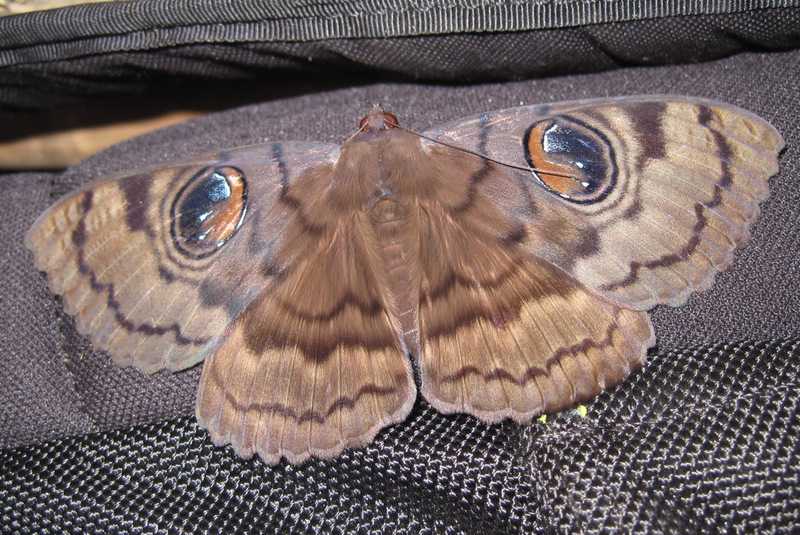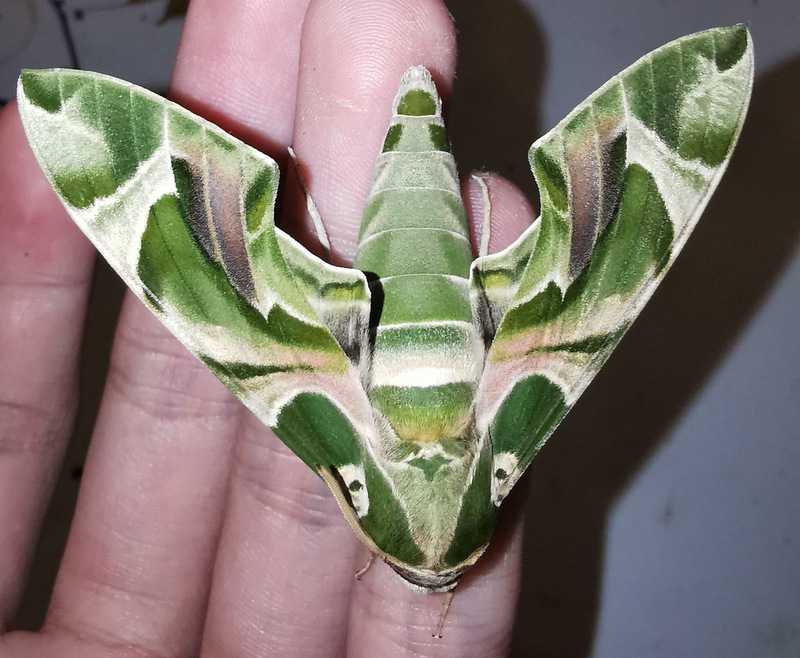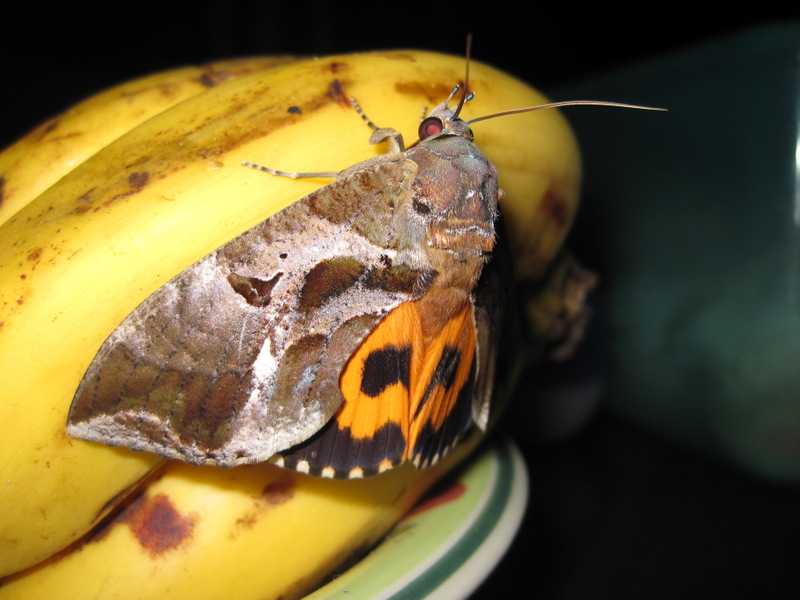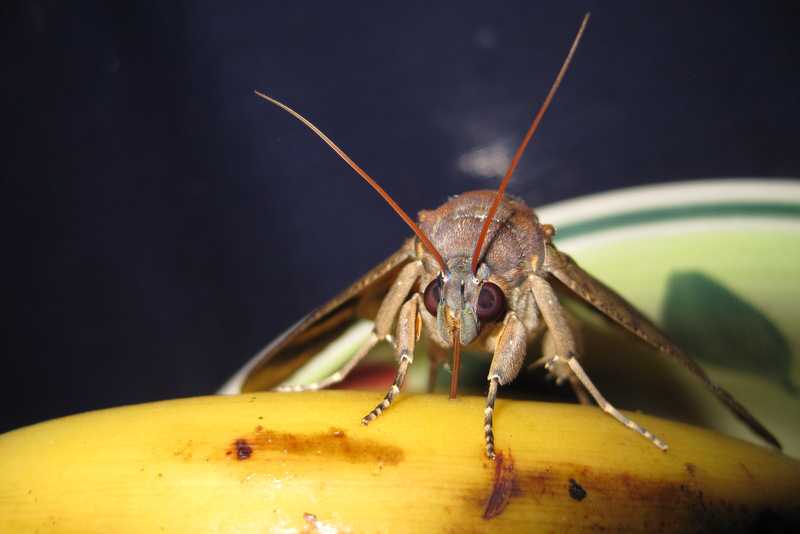
Leave a light on outside and soon you’ll have moths, the butterflies of the night, fluttering all around it. “Gamu-gamo” as the little ones are called, “mariposa” for the big ones. Sometimes drab, sometimes beautiful, sometimes with the most interesting markings.
Besides being active at night (nocturnal), you can tell a moth from a butterfly because they have thick or hairy bodies and don’t hold their wings together and straight up like butterflies often do. There antennae are often different as well. But moths are a very large and diverse group so there are many exceptions.

Just like butterflies, moths begin their lives as caterpillars (“higad” or “simutsang”). Caterpillars are a larval stage that is meant to do one thing: eat! They eat and and eat and eat until they grow large enough to have all the energy needed to form an adult moth.

From early in its life the caterpillar begins forming the organs and structures it needs for life as a moth. If you dissected a caterpillar, you would find the beginnings of legs and wings inside of its own body. But when it is ready for the full transformation, it will find a place to hide, stop moving, and slowly harden into a pupa (tilas).

Inside that protective covering the pupa is transforming into an adult moth. In warm regions it might happen within a month, but in cold regions the moth will often wait all the way until the next year to emerge.
The adult moth that comes out of the pupa is so different from the larva that created it you might think they were different animals. Sometimes they keep some of their old traits though. Do you see any family resemblance between the Oleander Hawkmoth caterpillar above and the adult moth that it will become below?

The next picture is a moth caterpillar that has been seen at Lilok Farm several times. What kind of moth will it become? We’re not sure! It belongs to the Tussock Moth family but we don’t know which species it would develop into. Since we don’t have pictures of all caterpillars, the only way to find out would be to raise the little guy until it grew up, and then we’d get to see ourselves what he will become. 🙂

Most of the time a few caterpillars here and there are harmless. But if you have too many of them, all that eating they do could damage your plants or trees. In some places certain kinds of moth caterpillars are a serious pest.
What do you do if too many caterpillars start infesting your crops or garden? The simplest solution is to pick them off. Caterpillars are quite visible and easy to remove – take them off with your fingers and find some birds or lizards to feed them to! (Or just drop them into a bucket of soapy water.) If it is a consistent problem, you can put an insect barrier net over your young plants so that the adult moths are unable to lay their eggs. In a worst-case scenario there are several organic control mechanisms, especially the caterpillar-infecting bacteria Bacillus thuringiensis, or BT.
But the most important way to avoid caterpillar problems is to avoid growing just one type of plant. Most caterpillars target certain plants and avoid others. In a healthy ecosystem, you end up with a few caterpillars eating a few leaves here and there, but you don’t get destruction (otherwise those plants would have disappeared from the wild).
The problem comes when people grow huge monocultures of just one type of plant, which encourages pests that eat that type of plant to expand out of control. So grow lots of different kinds of plants intermixed with each other. Mixing strong-smelling herbs like thyme or oregano into vegetable crops especially helpful – these smells are a sign of natural chemical defenses the plant is using to keep insect pests away. And having a healthy environment around your garden – one that encourages lots of birds, lizards, frogs, and other predators – is key for insuring that caterpillars and other pests don’t get out of balance.
Where do moths live?
Moths can be found anywhere, but different species will prefer various more specific habitats.
More moths seen at Lilok Farm
What do they eat?
The larvae (caterpillars) of moths feed on plants. Many of the adults do not eat at all, but some species will eat nectar or fruit juice.


Are they dangerous?
Moths are not dangerous.
Are they in danger?
There are 160,000 kinds of moth in the world, some are in danger and some are not. Whether a moth species is in trouble mostly depends on whether its habitat still exists.
But moths face another danger. You may notice that moths often circle around artificial lights. Scientists aren’t sure why they do this, but it can cause a big problem for them.
Many places in the world have thousands of homes and buildings with their lights on all of the time. These lights disrupt moth activity and have led to huge declines in the moth populations in those parts of the world, sometimes causing a loss of pollination of certain types of flowers. So if you don’t need to leave your lights on at night, don’t! All of the nighttime animals will appreciate it.
What is their scientific name and classification?
Moths are a “sub-order” known as Heterocera, part of the larger order Lepidoptera (which also includes the butterflies). Moths are characterized by their colorful scale-covered wings, feathery antennae, primarily nocturnal behavior, and their development as “caterpillars” which eventually form cocoons or pupae and become flying adults.
Some beautiful Filipino moths found in the Quezon area by entomologist Gernot Kunz

Hyposidra 
Comostola meritaria 
Tarsolepis 
Crambidae 
Creatonotos wilemani 
unknown moth species 
Crambidae 
Cyana 
Barsine 
Amplypterus 
Herochroma 
Cirrhochrista 
Geometridae 
Geometridae 
Parasa 
Pterocyclophora huntei 
Sphingidae 
Arctiinae 
Arctiinae 
unknown moth species 
Zythos turbata
How many different species of moths do you think live around your home? Do you see them on your walls, your windows? Upload their photos to the iNaturalist.org nature site and see what species you’ve found!




Pingback: The Little Geckos in Houses (butiki) | Animals of Tanay